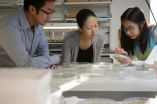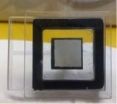(Press-News.org) MANHATTAN, Kansas — Pest insects may be sickened to learn to that researchers at Kansas State University have discovered a genetic mechanism that helps compromise their immune system.
Michael Kanost, university distinguished professor of biochemistry and molecular biophysics, led a study by Kansas State University researchers that looked at how protein molecules in the blood of insects function in insects' immune system. Insects use proteins that bind to the surface of pathogens to detect infections in their body.
"For example, when a mosquito transmits a pathogen like malaria, the parasite that causes the disease spends part of its life in the mosquito's blood," Kanost said. "It is often recognized by a genetic mechanism in the mosquito's immune system, which kills the parasite. This process is important in fully understanding how insects transmit diseases and how their immune system interacts with the pathogens they are transmitting so that we can disrupt it."
Researchers studied a protein called beta-1,3-glucan recognition protein, or GRP, from the blood of a caterpillar. They found that the GRP protein binds to a carbohydrate present in the cell wall of fungi known as beta-1,3-glucan. The GRP molecules bound to this carbohydrate, then assemble to form a larger complex of proteins. This protein complex on the surface of the pathogen may form a platform for attracting and activating other proteins from the blood, triggering immune responses that help kill pathogens in an insect's blood.
The findings may lead to new ways to control disease transmission from insects to humans and animals, as well as new methods for biocontrol of agricultural insect pests. It also sheds new light on how immune systems in organisms have evolved.
The study, "Self-association of an Insect Beta-1,3-Glucan Recognition Protein Upon Binding Laminarin Stimulates Prophenoloxidase Activation as an Innate Immune Response," was recently published in the Journal of Biological Chemistry.
The research team included Daisuke Takahashi, research associate, who conducted a majority of the experiments in Kanost's lab; Ramaswamy Krishnamoorthi, associate professor of biochemistry and bimolecular physics; Huaien Dai, a doctoral graduate; and former faculty member Yasuaki Hiromasa.
The team's study revolved around the tobacco hornworm. The insect's immune system has been studied by Kanost and others for more than 30 years.
Building on the decades of research on the tobacco hornworm's immune system, researchers concentrated on particular molecules in the blood that form pathways in which one molecule activates another molecule, leading to production of chemicals that kill pathogens.
Researchers used a variety of biochemical and biophysical experiments to understand how the protein molecules assemble on the surface of the pathogen. They found that clusters of five GRP protein molecules bind to a polysaccharide, a type of carbohydrate — beta-1,3-glucan in this case — along a larger carbohydrate molecule that makes a cell wall. Their work identified the spatial orientation of the GRP proteins in the cluster and showed that the protein-carbohydrate complexes stimulate an immune response in the caterpillar.
Understanding how the biochemical mechanism activates the immune system may enable scientists to disrupt the process, Kanost said. This could reduce insects' ability to transmit diseases to humans and animals.
It may also lead to new biocontrol of pest insects, as exploiting the mechanism could weaken and even turn off insects' immune system.
"There are fungal pathogens that are used to kill insect pests but that are harmless to humans," Kanost said. "If we understand how insect immune response fights off fungal infections, that might lead to better ways to use microbial control on the insects."
INFORMATION:
The National Institutes of Health funded the study.
Do consumers make the same choices when products such as beer, soft drinks, or candy bars are sold individually or in bundles? According to a new study in the Journal of Consumer Research, consumers purchase a greater variety of products when they are packaged individually rather than bundled together.
"When consumers choose multiple products, they are influenced by the mere mechanics of choosing, regardless of their product preference. Consumers are more likely to seek variety when choosing from single rather than bundled products," write authors Mauricio Mittelman (Universidad ...
DENVER (Oct. 14, 2014) – America's streets are designed and evaluated with a an inherent bias toward the needs of motor vehicles, ignoring those of bicyclists, pedestrians, and public transit users, according to a new study co-authored by Wesley Marshall of the University of Colorado Denver.
"The most common way to measure transportation performance is with the level-of-service standard," said Marshall, PhD, PE, assistant professor of civil engineering at the CU Denver College of Engineering and Applied Science, the top public research university in Denver. "But ...
Every year rotavirus causes half a million diarrhoea-related deaths amongst children in developing countries. Existing vaccines provide poor protection. The reason could be a widespread genetic resistance amongst children, according to virologists at Linköping University.
Acute diarrhoeal illnesses cause nearly one-fifth of all child deaths in developing countries. The most common cause is rotavirus. Improved sanitation and hygiene have had a limited effect on the spread of the illness. Today, vaccination is considered the most important method for reducing mortality. ...
Slow-healing or non-healing bone fractures in otherwise healthy people may be caused by gene variants that are common in the population, according to Penn State College of Medicine researchers.
"We found associations between certain gene polymorphisms and delayed fracture healing in a sample of patients," said J. Spence Reid, professor of orthopaedics and rehabilitation. "Our study was preliminary but it demonstrated the feasibility of a larger one, which we're now working to set up."
The identification of gene variants that delay fracture healing could lead to screening ...
The application of a new, precise way to turn genes on and off within cells, described online October 9, 2014 in two articles in the journal Cell, is likely to lead to a better understanding of diseases and possibly to new therapies, according to UC San Francisco scientists.
The key to the advance is a new invention, called the SunTag, a series of molecular hooks for hanging multiple copies of biologically active molecules onto a single protein scaffold used to target genes or other molecules. Compared to molecules assembled without these hooks, those incorporating the ...
EAST LANSING, Mich. – The discovery of a cellular snooze button has allowed a team of Michigan State University scientists to potentially improve biofuel production and offer insight on the early stages of cancer.
The discovery that the protein CHT7 is a likely repressor of cellular quiescence, or resting state, is published in the current issue of the Proceedings of the National Academy of Sciences. This cellular switch, which influences algae's growth and oil production, also wields control of cellular growth – and tumor growth – in humans.
Christoph ...
A program that provides guidance to primary care physicians about appropriately prescribing antibiotics for children is effective, but its improvements wear off after regular auditing and feedback are discontinued.
"Our findings suggest that interventions with outpatient healthcare providers should include continued feedback to clinicians to remain effective," said study leader Jeffrey S. Gerber, M.D., Ph.D., an infectious diseases specialist at The Children's Hospital of Philadelphia (CHOP).
Gerber and colleagues from CHOP published their research online Oct. 10 in ...
LAWRENCE — Few people devote time to pondering the ancient origins of the eel-like lamprey, yet the evolutionary saga of the bloodsucker holds essential clues to the biological roots of humanity.
Today, the Proceedings of the National Academy of Sciences published a description of fossilized lamprey larvae that date back to the Lower Cretaceous — at least 65 million years ago.
They're the oldest identified fossils displaying the creature in stages of pre-metamorphosis and metamorphosis.
"Among animals with backbones, everything, including us, evolved from ...
DURHAM, N.C. -- Researchers have known for decades that stress contributes to heart disease. But a new analysis by researchers at Duke Medicine shows mental stress may tax women's hearts more than men's.
The research appears online Oct. 13, 2014, in the Journal of the American College of Cardiology.
"Normally when under stress, we fight back or run away. In order to do that, we need to pump more blood to the body," said Wei Jiang, M.D., the study's senior author and professor of medicine, psychiatry and behavioral sciences at the Duke University School of Medicine. ...
Washington D.C., October 14, 2014 -- Even as the 2014 Nobel Prize in Physics has enshrined light emitting diodes (LEDs) as the single most significant and disruptive energy-efficient lighting solution of today, scientists around the world continue unabated to search for the even-better-bulbs of tomorrow.
Enter carbon electronics.
Electronics based on carbon, especially carbon nanotubes (CNTs), are emerging as successors to silicon for making semiconductor materials. And they may enable a new generation of brighter, low-power, low-cost lighting devices that could challenge ...



